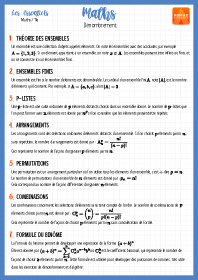5. Produit cartésien
- Le produit cartésien de l'ensemble $\mathrm A$ par l'ensemble $\mathrm B$, noté $\rm A \times B$, est l'ensemble des couples $(a~;b)$ tels que $a \in \mathrm A$ et $b \in \mathrm B$.
- Le produit cartésien des ensembles $\mathrm E_1$, $\mathrm E_2$, $\mathrm E_3$, $\ldots$, $\mathrm E_p$ est l'ensemble noté $\mathrm E_1 \times \mathrm E_2 \times \mathrm E_3 \times \ldots \times \mathrm{E_p}$.
Le produit cartésien $\underbrace{\mathrm{E} \times \mathrm{E} \times \ldots \times \mathrm{E}}_{\text {p fois}}$ est noté $\mathrm{E^p}$
6. Propriétés des cardinaux
Pour tous ensemble finis $\mathrm A$, $\mathrm B$, $\mathrm E$, $\mathrm E_1$, $\mathrm E_2$, $\mathrm E_3$, $\ldots$, $\mathrm {E_p}$, on a :
- $\operatorname{card}(\mathrm{A \cup B})=\operatorname{card}(\mathrm A)+\operatorname{card}(\mathrm B)$ si $\rm A \cap B=\emptyset$
- Si $\mathrm E$ est un ensemble fini et si $\mathrm E_1$, $\mathrm E_2$, $\mathrm E_3$, $\ldots$, $\rm E_p$ sont des ensembles formant une partition de $\mathrm E$, on a : $\operatorname{card}(\mathrm E)=\operatorname{card}\left(\mathrm E_1\right)+\operatorname{card}\left(\mathrm E_2\right)$ $+$ $\operatorname{card}\left(\mathrm E_3\right)+\ldots+\operatorname{card}\left(\mathrm{E_p}\right)$.
- $\operatorname{card}(\mathrm A)+\operatorname{card}(\overline{\mathrm A})=\operatorname{card}(\mathrm E)$.
($\mathrm A$ partie d'un ensemble fini $\mathrm E)$
- $\operatorname{card}(\rm A \cup B)=\operatorname{card}(A)$ $+$ $\operatorname{card}(\mathrm B)-\operatorname{card}(\rm A \cap B)$.
- $\operatorname{card}(\rm A \times B)=\operatorname{card}(A) \times \operatorname{card}(\mathrm B)$.
- $\operatorname{card}\left(\rm E_1 \times E_2 \times E_3 \times \ldots \times E_p\right)$ $\rm =\operatorname{card}\left(E_1\right) \times \operatorname{card}\left(E_2\right)$ $\times $ $\operatorname{card}\left(\mathrm E_3\right) \times \ldots \times \operatorname{card}\left(\rm E_R\right)$
- $\rm \operatorname{card}\left(E^P\right)=(\operatorname{card}(E))^P$
7. (p-listes)
Soit $\mathrm E$ un ensemble à $\mathrm n$ éléments et $\mathrm p$ un nombre entier naturel non nul. On appelle $\bf\color{orange}{p–liste}$ de $\mathrm E$ tout élément de l'ensemble $\mathrm{E^p}$ $(\rm p–uplet)$.
Propriété :
Le nombre de $\rm p–uplets$ ou de $\rm p–listes$ d'un ensemble à $\mathrm n$ éléments est $\mathrm{n}^{\mathrm{p}}$.
Cas particuliers
Arrangements
Soit $\mathrm E$ un ensemble à $\mathrm n$ éléments et $\mathrm p$ un nombre entier naturel non nul tel que : $\mathrm{p} \leq \mathrm{n}$.
- On appelle arrangement de $\rm p$éléments de $\mathrm E$, tout $\rm p–uplet$ ou $\rm p–liste$ d'éléments de $\mathrm E$ deux à deux distincts.
- Le nombre d'arrangements de $\rm p$ éléments d'un ensemble $\mathrm E$ à $\mathrm n$ éléments est :
$\rm A_n^p=\dfrac{n!}{(n-p)!}=n(n-1)(n-2)$ $\rm \ldots(n-p+1)$
$\rm A_n^0=1$
Permutation
Soit $\mathrm E$ un ensemble à $\mathrm n$ éléments.
- On appelle permutation de $\mathrm E$ tout arrangement des $\mathrm n$ éléments de $\mathrm E$.
- Le nombre de permutations d'un ensemble à $\mathrm n$ éléments est $\mathrm n$ !
8. Combinaisons
Soit $\mathrm E$ un ensemble à $\mathrm n$ éléments et $\mathrm p$ un nombre entier naturel non nul tel que : $\mathrm{p} \leq \mathrm{n}$.
- On appelle combinaison de $\mathrm p$ éléments de $\mathrm E$ tout sous-ensemble de $\mathrm E$ ayant $\mathrm p$ éléments.
- Le nombre de combinaisons de $\mathrm p$ éléments d'un ensemble à $\mathrm n$ éléments est :
$$\rm C_n^p=\dfrac{A_n^p}{p!}=\dfrac{n!}{p!(n-p)!}$$
- On a : $\mathrm{C}_{\mathrm{n}}^{\mathrm{n}-\mathrm{p}}=\mathrm{C}_{\mathrm{n}}^{\mathrm{p}}$
- Si de plus $\rm 0 < p < n$, alors on a : $\mathrm{C}_{\mathrm{n}-1}^{\mathrm{p}-1}+\mathrm{C}_{\mathrm{n}-1}^{\mathrm{p}}=\mathrm{C}_{\mathrm{n}}^{\mathrm{p}}$
(Triangle de Pascal)
Formule du binôme de Newton
Soit $\mathrm a$ et $\mathrm b$ deux nombres réels et $\mathrm n$ un nombre entier naturel non nul. On a :
$\rm (a+b)^n=C_n^0 a^n+C_n^1 a^{n-1} b^1$ $+$ $\rm C_n^2 a^{n-2} b^2+\cdots+C_n^p a^{n-p} b^p$ $\rm \ldots+C_n^{n-1} a^1 b^{n-1}+C_n^n b^n$
Différents types de tirages
On tire $\mathrm p$ boules parmi $\mathrm n$ boules existantes dans un sac $\rm (p \leq n)$.
$\begin{array}{|c|c|} \hline \textbf{Type de tirage} & \begin{array}{l}\textbf{Nombre de}\\ \textbf{façons possibles}\end{array} \\ \hline \text{Le tirage simultané} & \mathrm{C^p_n} \\ \hline \begin{array}{l}\text{Le tirage successif}\\ \text{sans remise}\end{array} & \mathrm{A^p_n} \\ \hline \begin{array}{l}\text{Le tirage successif}\\ \text{avec remise}\end{array} & \rm n^p \\ \hline \end{array}$



